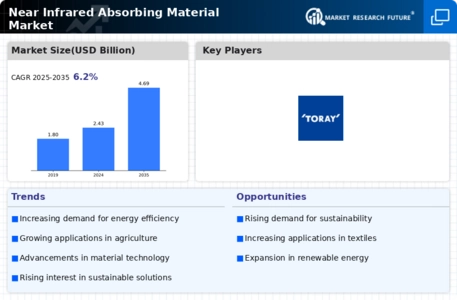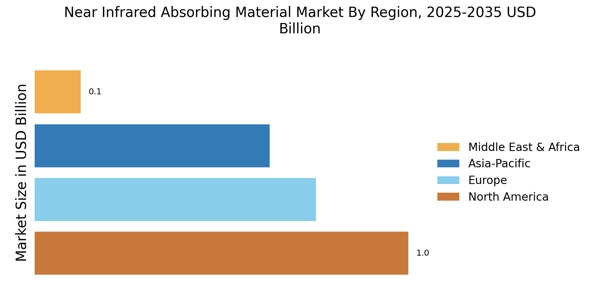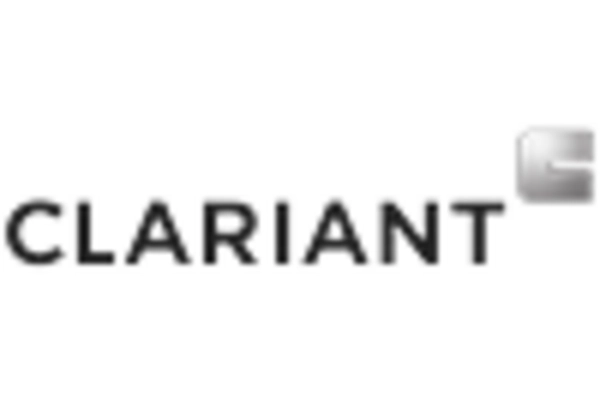Diverse Industrial Applications
The Near Infrared Absorbing Material Market is bolstered by the diverse applications of these materials across various industries. From construction to textiles, the versatility of near-infrared absorbing materials allows for their integration into a wide range of products. In the construction sector, these materials are utilized in roofing and wall coatings to improve energy efficiency and thermal comfort. In textiles, they are employed to create fabrics that provide UV protection and temperature regulation. The increasing adoption of these materials in multiple sectors is indicative of their growing importance in enhancing product performance and sustainability. As industries continue to explore innovative applications, the Near Infrared Absorbing Material Market is expected to witness robust growth, driven by the demand for multifunctional materials that cater to specific needs.
Advancements in Material Science
Innovations in material science are significantly influencing the Near Infrared Absorbing Material Market. Researchers and manufacturers are continuously developing new formulations and composites that enhance the performance of near-infrared absorbing materials. These advancements include the creation of nanostructured materials that exhibit superior absorption properties and improved stability under various environmental conditions. The market is witnessing a shift towards multifunctional materials that not only absorb near-infrared radiation but also provide additional benefits such as UV protection and durability. This evolution in material science is expected to drive market growth, as industries increasingly seek high-performance solutions that meet stringent regulatory standards and consumer expectations. The ongoing research and development efforts are likely to result in innovative products that cater to diverse applications, further expanding the Near Infrared Absorbing Material Market.
Expansion of the Automotive Sector
The expansion of the automotive sector is a significant driver for the Near Infrared Absorbing Material Market. As automotive manufacturers strive to enhance vehicle performance and fuel efficiency, the integration of near-infrared absorbing materials into vehicle coatings and components is becoming increasingly prevalent. These materials help in regulating cabin temperatures, thereby reducing the need for air conditioning and improving overall energy efficiency. The automotive industry is projected to witness substantial growth, with a focus on lightweight materials and advanced coatings that incorporate near-infrared absorption properties. This trend not only aligns with consumer preferences for energy-efficient vehicles but also supports regulatory compliance regarding emissions. Consequently, the Near Infrared Absorbing Material Market is likely to benefit from the automotive sector's expansion, as manufacturers seek innovative solutions to meet evolving market demands.
Growing Awareness of Climate Change
The Near Infrared Absorbing Material Market is being propelled by the growing awareness of climate change and its impacts. As governments and organizations worldwide commit to reducing greenhouse gas emissions, there is a heightened focus on materials that can contribute to energy savings and lower carbon footprints. Near-infrared absorbing materials are increasingly recognized for their potential to enhance energy efficiency in buildings and vehicles, thereby reducing reliance on fossil fuels. This awareness is leading to the implementation of stricter regulations and incentives for the use of energy-efficient materials, which in turn is fostering growth in the Near Infrared Absorbing Material Market. The alignment of market offerings with sustainability goals is likely to attract investments and drive innovation, creating a favorable environment for the expansion of this market.
Rising Demand for Energy Efficiency
The Near Infrared Absorbing Material Market is experiencing a notable surge in demand driven by the increasing emphasis on energy efficiency across various sectors. As industries strive to reduce energy consumption and lower operational costs, the adoption of materials that can effectively absorb near-infrared radiation becomes paramount. This trend is particularly evident in the construction and automotive sectors, where energy-efficient solutions are sought to enhance thermal management. According to recent estimates, the energy-efficient materials market is projected to grow significantly, with near-infrared absorbing materials playing a crucial role in this transformation. The integration of these materials into building materials and vehicle coatings not only improves energy efficiency but also contributes to sustainability goals, thereby propelling the Near Infrared Absorbing Material Market forward.


















Leave a Comment